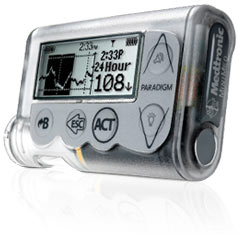Going wireless with diabetes treatment


I was first diagnosed with Type 2 diabetes a decade ago. Type 2 diabetes now afflicts over 20 million Americans, and treatment can vary from simple diet control to multiple injections of insulin daily. I have been in the insulin injection club for years, and after discussions with my healthcare provider I am considering entering the world of the "pumpers." These are the diabetics using an insulin pump 24/7 to keep total control over their glucose level, the best way to minimize long-term complications caused by diabetes.
What does this have to to with covering mobile technology? Plenty, as my research into insulin pump technology demonstrates. Insulin pump treatment consists of two parts: the pump itself, a highly calibrated device the size of the pager of old, and glucose monitors which keep an eye on the internal blood levels at all times. These two work together through wireless communications, in a totally mobile configuration. You probably interact with folks using insulin pump technology every day, and just don't know it.
While the insulin pump itself can be (and usually is) worn under clothing to hide it, there are glucose meters that can pair up to the pump wirelessly. These can be simple, like the meters used with the finger prick method for measuring glucose in the blood, that send the metered results to the insulin pump. Insulin dosage is adjusted appropriately based on the measured results in real-time, resulting in insulin treatment much like that of the human body. Some pumps can constantly monitor the glucose blood level in real-time and make adjustments automatically, much like the human body.
Just about all modern glucose meters and insulin pumps can connect to a laptop or computer via USB to upload recorded information. This provides detailed tracking by the user, useful for determining what is happening with the diabetic's all-important glucose level. Some of these software solutions can be remotely accessed by the healthcare provider to make proper adjustments to the treatment from afar.
I am close to determining what equipment I will be using to treat my diabetes, but nothing is finalized yet. I can use all of the advice I can get with the complicated decision process concerning the gear, so please leave a comment in the TalkBack section if you can. I am particularly eager to hear what pumps and meters others might be using, and how well that is working out.